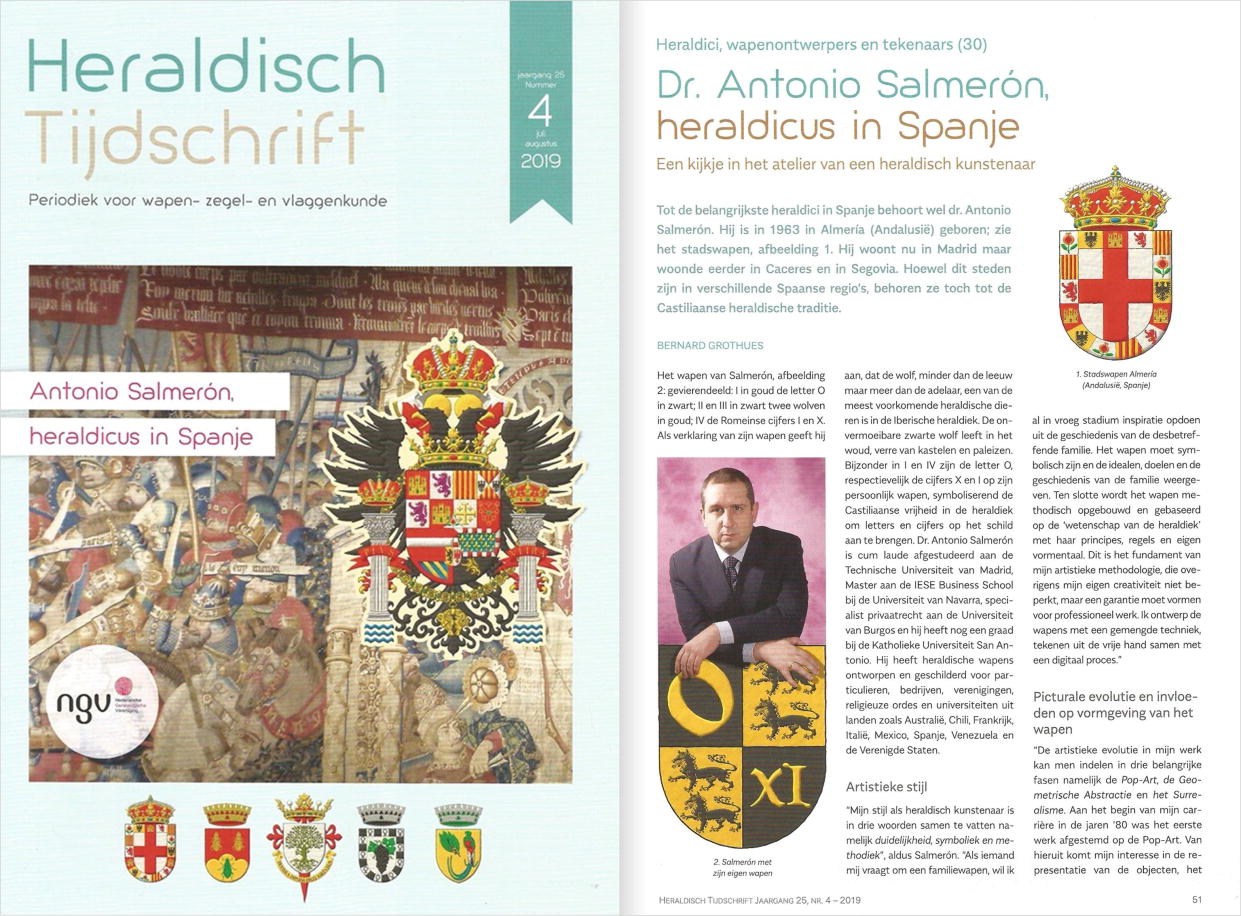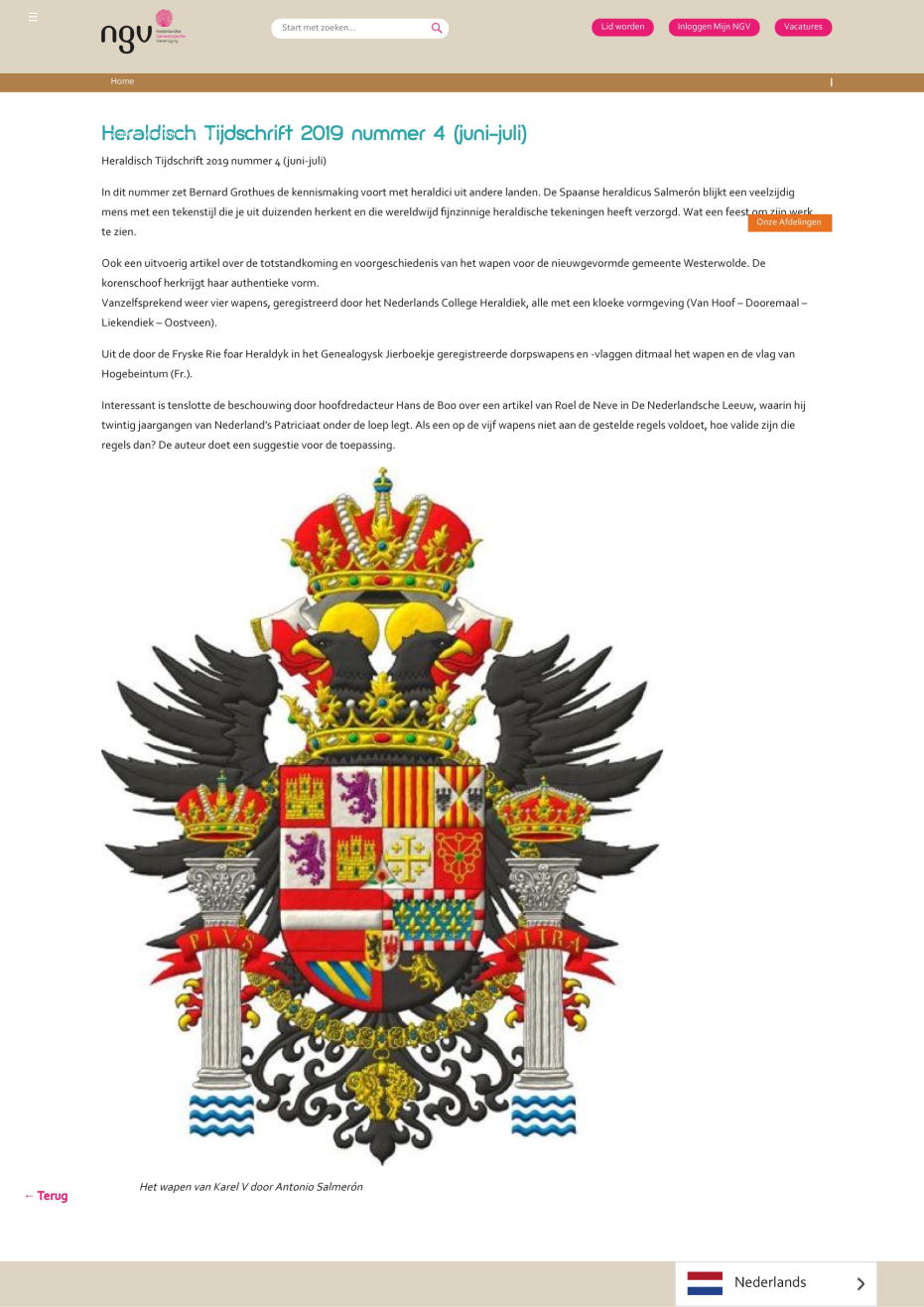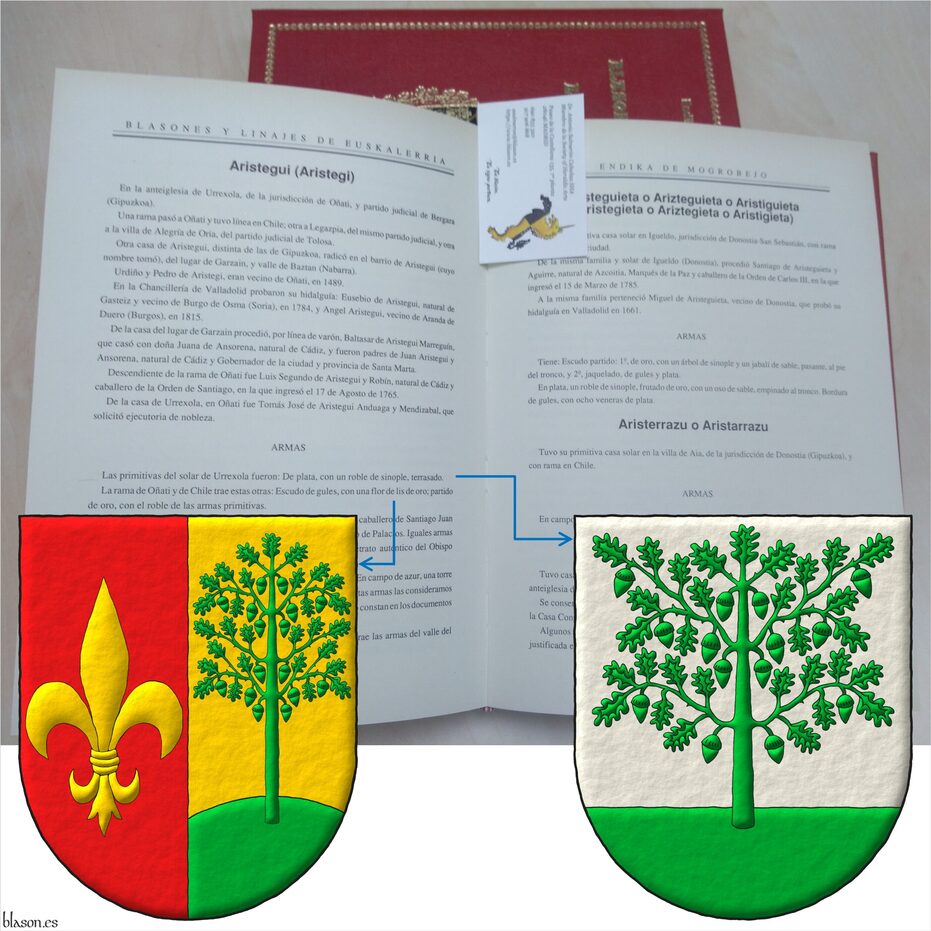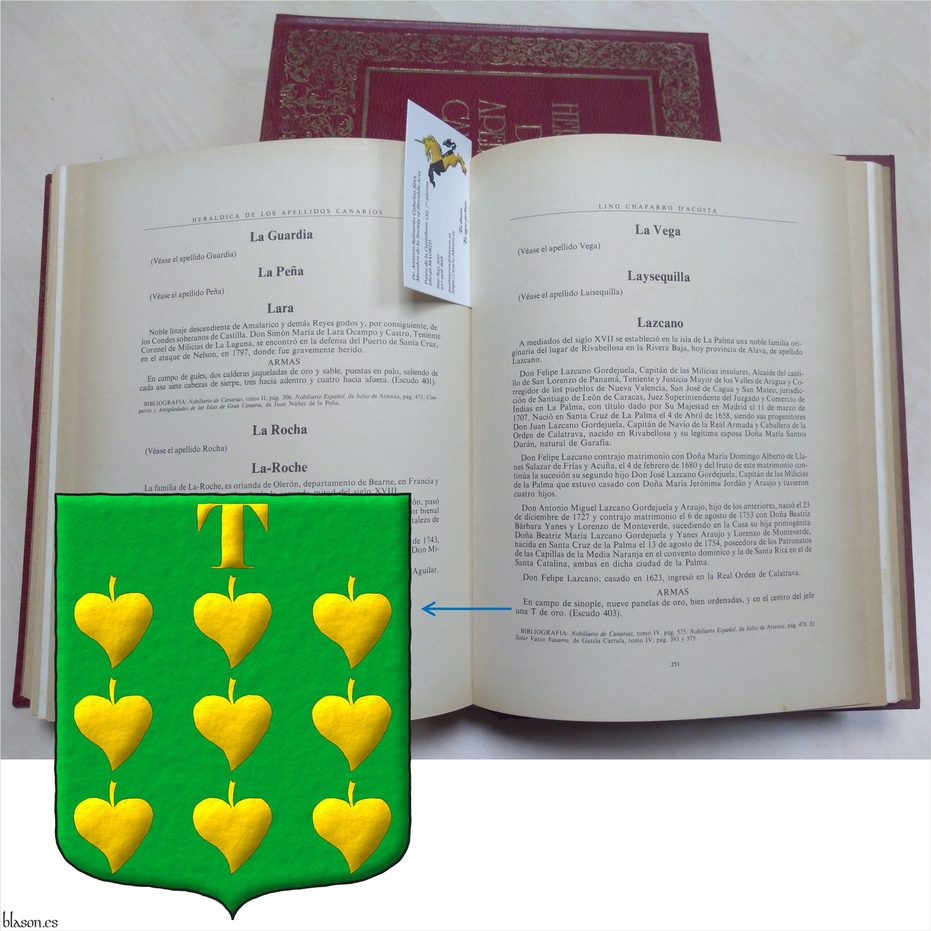
Dr. Antonio Salmerón, heraldicus in Spanje
Heraldisch Tijdschrift is the bulletin of the Dutch Genealogical Society - Heraldic Division. Bernard Grothues, his heraldic copywriter, has written an article about me for the number 4 of July-August of 2019, and 3 coats of arms created by me and 3 emblazoned be me appear on its cover. [Grothues, B.; 2019; pages 51-53].


![Ver [Pennick, N.; 2015] en referencias bibliográficas. Libro abierto, hojas de plata, filo de oro, guardas de gules, tapas de sable.](../css/Libro.Bibliografia.png)
Pennick, N.; 2015
Nigel Pennick, «Pagan Magic of the Northern Tradition: Customs, Rites, and Ceremonies», edited by Simon and Schuster, publicado por Destiny Books, ISBN.13 9781620553909, ISBN.10 1620553902, alternative ISBN.13 9781620553893, 352 pages, New York, 21th of May of 2015
On page 119, Nigel Pennick wrote «According to Aristotelian precepts, each of the metals and tinctures», maybe he should have written heraldic term color, «possesses a spiritual virtue related to a particular planetary sphere. Or signifies and relates to the Sun; Argent, the Moon; Sable, Saturn; Azure, Jupiter; Gules, Mars; Vert, Venus; and Purpure, Mercury».
Bibliographical reference of century XXI.
Author: Pennick, Nigel.
External resource:


![Ver [Mogrobejo Zabala, E. de; 1991] en referencias bibliográficas. Libro abierto, hojas de plata, filo de oro, guardas de gules, tapas de sable.](../css/Libro.Bibliografia.png)
Mogrobejo Zabala, E. de; 1991
Endika de Mogrobejo Zabala, «Blasones y Linajes de Euskalerria», 10 volumes, Volume I A-Alcerreca, Volume II Alciba-Angui, Volume III Angulo-Astu, Volume IV Astun-Bun, Volume V Busta-Elua, Volume VI Elus-Gorniz, Volume VII Gordu-Laca, Volume VIII Lacar-Merca, Volume IX Mere-Salez, Volume X Salinas-Z, edited by Editorial Amigos del Libro Vasco, printed by Grafo SA, ISBN of the complete work 84-7886-026-6, legal Deposit BI-469-1991, Bilbao, 1991.
Bibliographical reference of century XX.
Classification: De bibliotheca, Black and white with color plates and Castilian language.
Author: Mogrobejo Zabala, Endika de.


Lazcano, lineage of the Canary Islands
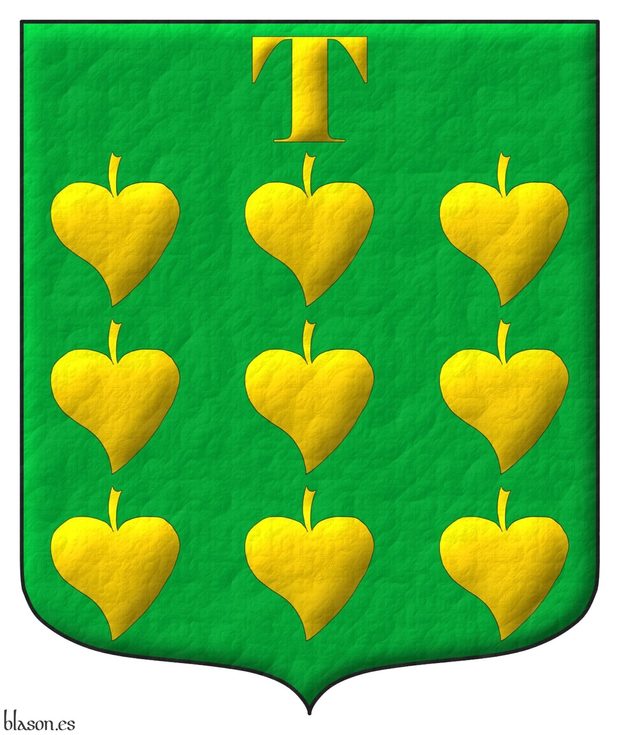
Blazon of the lineage Lazcano in the Canary Islands.
Vert, nine Poplar leaves ordered, in chief a «T» letter Or.
Illuminated and leather finishing.
It can be consulted at [Chaparro D'Acosta L.; 1979; página 251].
Blazon keywords: Without divisions, Vert, Letter, Poplar leaf, Or and Nine.
Style keywords: Leather, Outlined in sable and Illuminated.
Classification: Interpreted.


![Ver [Chaparro D'Acosta L.; 1979] en referencias bibliográficas. Libro abierto, hojas de plata, filo de oro, guardas de gules, tapas de sable.](../css/Libro.Bibliografia.png)
Chaparro D'Acosta L.; 1979
Lino Chaparro D'Acosta, «Heráldica de los Apellidos Canarios», foreword by Vicente de Cadenas y Vicent, 2 volumes, Volume I from A to L, 285 surnames, 293 pages, Volume II from M to Z and a heraldic dictionary, 387 surnames, 439 pages, edited by Estudios Tecnicos del Blason, ISBN of the complete work 84-300-2000-4, ISBN of Volume I 84-300-1989-8, ISBN of Volume I II 84-300-418010-8, Las Palmas de Gran Canaria, 1979.
Bibliographical reference of century XX.
Classification: Black and white with color plates and Castilian language.
The author is Chaparro D'Acosta, Lino.
The following article cites this bibliographic reference:


![Ver [García Carraffa, A.; García Carraffa, A.; 1920] en referencias bibliográficas. Libro abierto, hojas de plata, filo de oro, guardas de gules, tapas de sable.](../css/Libro.Bibliografia.png)
García Carraffa, A.; García Carraffa, A.; 1920
Alberto García Carraffa y Arturo García Carraffa, «Heraldic and Genealogical Dictionary of Spanish and American Surnames», 88 volumes, printed by Antonio Marzo, Madrid, 1920.
Contents of the 88 volumes
- Volume I. The science of heraldry or blazon.
- Volume II. Dictionary of blazonry terms; Methods of blazoning; Index of heraldic.
- Volume III. Aanda - Adan de Yarza.
- Volume IV. Adana - Aich.
- Volume V. Aichiaivoli - Alcocer.
- Volume VI. Alcoces - Almuzara.
- Volume VII. Aloi - Alzuru.
- Volume VIII. Allado - Anés.
- Volume IX. Anescar - Aragón.
- Volume X. Aragonés - Arecha.
- Volume XI. Aréchaga - Aronal.
- Volume XII. Aronsena - Azzia.
- Volume XIII. Baana - Barbena.
- Volume XIV. Barbens - Basani.
- Volume XV. Basanta - Benavides.
- Volume XVI. Bencarza - Blancazo.
- Volume XVII. Blanco - Bolet.
- Volume XVIII. Boliaga - Brañas.
- Volume XIX. Braramuño - Buzón.
- Volume XX. Caamaño - Cadelo.
- Volume XXI. Cadena - Campani.
- Volume XXII. Campano - Cañellas.
- Volume XXIII. Cañete - Caroli.
- Volume XXIV. Carondelet - Cassador.
- Volume XXV. Castant - Celaeta.
- Volume XXVI. Celain - Claver.
- Volume XXVII. Claveria - Cutuneguieta.
- Volume XXVIII. Chavelas - Desportell.
- Volume XXIX. Despou - Duzay.
- Volume XXX. Ebazquin - Ellauri.
- Volume XXXI. Ellul - Escolonea.
- Volume XXXII. Escorcia - Ezterripa.
- Volume XXXIII. Fabalis - Fernández de Espinosa.
- Volume XXXIV. Fernández de Estenoz - Figuereido.
- Volume XXXV. Figuera - Franco.
- Volume XXXVI. Francoli - Gamboa.
- Volume XXXVII. Gambacorta - García de la Plata.
- Volume XXXVIII. García y Portilla - Gil de Zúñiga.
- Volume XXXIX. Gilabert - Gómez de la Serna.
- Volume XL. Gómez de Silva - Gorriti.
- Volume XLI. Górriz - Guil.
- Volume XLII. Guilisagasti - Haro.
- Volume XLIII. Hartos - Hilera.
- Volume XLIV. Hilgueros - Ibarrundia.
- Volume XLV. Ibars de Povil - Irazusta.
- Volume XLVI. Irgas - Izurzu.
- Volume XLVII. Jabaloyas - Juyá.
- Volume XLVIII. Labaca - Larburu.
- Volume XLIX. Lardíes - Lazcamburu.
- Volume L. Lazcano - Lizárraga.
- Volume LI. Lizarralde - Luzuriaga.
- Volume LII. Llabiá - Malda.
- Volume LIII. Maldonado - Marín.
- Volume LIV. Marina - Marroquin.
- Volume LV. Marrubiza - Mendibure.
- Volume LVI. Mendicoa - Mesares.
- Volume LVII. Mescua - Moncayo.
- Volume LVIII. Monclares - Moradell.
- Volume LIX. Moraga - Mozo.
- Volume LX. Mozo de la Torre - Muzúa.
- Volume LXI. Naarruza - Nelia.
- Volume LXII. Neira - Ocaranza.
- Volume LXIII. Ocariz - Olcina.
- Volume LXIV. Olcinellas - Ordines.
- Volume LXV. Ordonias - Oruna.
- Volume LXVI. Oruña - Ozticain.
- Volume LXVII. Pablo or de Pablo - Palandegui or Palantegui.
- Volume LXVIII. Palafurgell - Parro.
- Volume LXIX. Parrondo - Pellón.
- Volume LXX. Pemán - Pérez de Arramendia.
- Volume LXXI. Pérez de Arroyo - Pillado.
- Volume LXXII. Pimentel - Poli.
- Volume LXXIII. Polo - Portero.
- Volume LXXIV. Portes - Puig - Gat.
- Volume LXXV. Puigbaco - Quincoces.
- Volume LXXVI. Quinquer - Rami.
- Volume LXXVII. Ramírez - Rezusta.
- Volume LXXVIII. Riabeyo - Rizo.
- Volume LXXIX. Roa - Romaza.
- Volume LXXX. Romero or Romeo, O Romeu - Ruy de Peras.
- Volume LXXXI. Sáa - Salinas.
- Volume LXXXII. Sall - Santángel or Sant Angel.
- Volume LXXXIII. Santaolaria or Santolaria - Sayola.
- Volume LXXXIV. Sebastián - Sirtema.
- Volume LXXXV. Sirvent or Sirvente - Susunaga.
- Volume LXXXVI. Tabar or Tavar - Tolosans.
- Volume LXXXVII. Tolrá - Tutor.
- Volume LXXXVIII. Uacué - Urriza.
Bibliographical reference of century XX.
Classification: Castilian language and Black and white with color plates.
Authors: García Carraffa, Alberto and García Carraffa, Arturo.
External resources:
Internal resources: GarciaCarrafiaAyA1920.Tomo.01.pdf PDF format, GarciaCarrafiaAyA1920.Tomo.04.pdf PDF format and GarciaCarrafiaAyA1920.Tomo.08.pdf PDF format.


![Ver [Rodríguez de Lena, P.; Century XVI] en referencias bibliográficas. Libro abierto, hojas de plata, filo de oro, guardas de gules, tapas de sable.](../css/Libro.Bibliografia.png)
Rodríguez de Lena, P.; Century XVI
Rodríguez de Lena, Pero, «Libro del passo honroso defendido por el excelente cavaliero Suero de Quiñones», chronicle, 26 centimeters, Leon, 1434.
Introduction
It is a medieval chronicle written by the notary and chronicler Pero Rodríguez de Lena, documenting the chivalric deeds of Suero de Quiñones and his ten companions during the famous «Passo Honroso» at the bridge of Órbigo, León, in 1434.
From July 10 to August 9, 1434, Suero de Quiñones and 9 knights, the defenders, challenged any knight, the challengers, who wished to cross the bridge to a joust, an event that drew the attention of pilgrims traveling to the shrine of Santiago de Compostela.
The challenge of breaking 300 lances
Suero describes himself as being in prison for this virtuous lady, and he wore an iron collar every Thursday as a sign of this prison. His pledge to break 300 lances or defend the bridge, against all knights in the world who wished to cross it, for thirty days was a way to fulfill the conditions of this metaphorical imprisonment.
To fulfill his vow and prove his honor, Suero set the price for his rescue as the breaking of 300 lances in combat, each with a Milanese iron tip.
Nine other knights joined him in this noble defense at the Passo Honroso.Contents
The original chronicle contains the full account of the 30 days of jousting, during which 164 jousts were held, along with the 22 rules governing the competition.
Suero and his companions vowed to break 300 lances in this chivalric endeavor but were forced to stop after 164 jousts, having fulfilled their oath to defend the bridge.
The chronicle also includes details of the knights who participated and the outcomes of each joust.
The 10 defenders
- Suero de Quinones, broke 10 defenders' lances.
- Lope de Estuñiga, broke 17 defenders' lances.
- Diego de Bazan, broke 16 defenders' lances.
- Pedro de Nava, broke 10 defenders' lances.
- Aluaro, or Suero son of Alvar Gomez, broke 14 defenders' lances.
- Sancho de Ravanal, broke 33 defenders' lances.
- Lope de Aller, broke 12 defenders' lances.
- Diego de Benavides, broke 10 defenders' lances.
- Pedro de los Rios, broke 18 defenders' lances.
- Gomez de Villacorta, broke 24 defenders' lances.
The 68 conquerors
The phrase «had his lance broken» indicates the number of times the conqueror's lance was broken during the jousts by Suero and his companions, the defenders.
- Micer Arnaldo de la Floresta Bermeja, from Germany, rode in 6 courses and had his lance broken 2 times.
- Mosen Juan Fabla, from Valencia, rode in 19 courses and had his lance broken 3 times.
- Mosen Pero Fabla, from Valencia, rode in 5 courses and had his lance broken 3 times.
- Rodrigo de Zayas, from Aragon, rode in 23 courses and had his lance broken 3 times.
- Antón de Funes, aragonés, rode in 15 courses, had his lance broken 3 times.
- Sancho Zapata, aragonés, rode in 19 courses, had his lance broken 3 times.
- Fernando de Liñán, aragonés, rode in 14 courses, had his lance broken 1 time.
- Francisco Muñoz, aragonés, rode in 16 courses, had his lance broken 2 times.
- Mosen Gonzalo de Leori, aragonés, rode in 18 courses, had his lance broken 4 times.
- Juan de Estamari, aragonés, rode in 8 courses, had his lance broken 3 times.
- Jofre Jardín, aragonés, rode in 3 courses, had his lance broken 3 times.
- Francisco de Faces, aragonés, rode in 27 courses, had his lance broken 3 times.
- Mosen Per Davio, aragonés, rode in 23 courses, had his lance broken 2 times.
- Mosen Francés Davio, aragonés, rode in 23 courses, had his lance broken 2 times.
- Vasco de Varrionuevo, rode in 7 courses, had his lance broken 3 times.
- Juan de Soto, rode in 24 courses, had his lance broken 3 times.
- Diego de Mancilla, rode in 1 course, had his lance broken 1 time.
- Rodrigo de Ulloa, rode in 7 courses, had his lance broken 3 times.
- Juan Freyre de Andrada, rode in 3 courses, had his lance broken 3 times.
- Lope de Mendoza, rode in 6 courses, had his lance broken 3 times.
- Juan de Gamoz, catalán, rode in 9 courses, had his lance broken 3 times.
- Mosen Bernal de Requesenes, catalán, rode in 8 courses, had his lance broken 3 times.
- Pedro de Vesga, rode in 21 courses, had his lance broken 3 times.
- Juan de Villalobos, rode in 8 courses, had his lance broken 3 times.
- Gonzalo de Castañeda, rode in 5 courses, had his lance broken 2 times.
- Alonso Quijada, rode in 12 courses, had his lance broken 3 times.
- Bueso de Solís, rode in 11 courses, had his lance broken 3 times.
- Juan de Castellanos, rode in 5 courses, had his lance broken 3 times.
- Gutierre Quijada, rode in 4 courses, had his lance broken 3 times.
- Rodrigo de Quijada, rode in 2 courses, had his lance broken 2 times.
- García Osorio, rode in 8 courses, had his lance broken 3 times.
- Diego Zapata, rode in 20 courses, had his lance broken 3 times.
- Alonso de Cavedo, rode in 19 courses, had his lance broken 3 times.
- Arnoa de Novalles, aragonés, rode in 20 courses, had his lance broken 3 times.
- Ordeño de Valencia, rode in 10 courses.
- Rodrigo de Xuara, rode in 17 courses, had his lance broken 2 times.
- Juan de Merlo, rode in 3 courses, had his lance broken 2 times.
- Alonso Deza, rode in 13 courses, had his lance broken 6 times.
- Galaor Mosquera, rode in 4 courses, had his lance broken 3 times.
- Pero Vázquez de Castilblanco, rode in 22 courses, had his lance broken 3 times.
- Loque de la Torre, rode in 6 courses, had his lance broken 4 times.
- Martín de Arneyda, rode in 14 courses, had his lance broken 3 times.
- Gonzalo de León, rode in 18 courses, had his lance broken 2 times.
- Juan de Soto, rode in 14 courses, had his lance broken 3 times.
- Juan Vázquez de Olivera, rode in 19 courses, had his lance broken 3 times.
- Pedro de Linares, rode in 16 courses, had his lance broken 1 time.
- Antón Deza, rode in 5 courses, had his lance broken 3 times.
- Juan de Carvallo, rode in 20 courses, had his lance broken 2 times.
- Pedro Carnero, rode in 8 courses, had his lance broken 3 times.
- Pedro de Torrecilla, rode in 4 courses.
- Diego de San Román, rode in 9 courses, had his lance broken 2 times.
- Pedro de Negrete, rode in 5 courses, had his lance broken 3 times.
- Alvaro Cubel, rode in 5 courses, had his lance broken 3 times.
- Pedro de Silva, rode in 12 courses, had his lance broken 3 times.
- Juan de Quintanilla, rode in 4 courses, had his lance broken 3 times.
- Gonzalo de Barros, rode in 4 courses, had his lance broken 2 times.
- Martín de Guzmán, rode in 15 courses, had his lance broken 3 times.
- Mosen Riembao de Cervera, catalán, rode in 1 course, had his lance broken 1 time.
- Mosen Franci de Valle, catalán, rode in 1 course, had his lance broken 1 time.
- Esberto de Claramonte, aragonés, the only one who died, rode in 9 courses, had his lance broken 1 time.
- Micer Luis de Aversa, italiano, rode in 5 courses, had his lance broken 1 time.
- Pero Gil de Abreo, portugués, rode in 4 courses, had his lance broken 1 time.
- Arnao Bojué, bretón, rode in 2 courses, had his lance broken 2 times.
- Sancho de Perrera, rode in 2 courses, had his lance broken 2 times.
- Lope de Perrera, rode in 6 courses, had his lance broken 1 time.
- Mosen Francés Perobaste, rode in 12 courses.
- Don Juan de Portugal, rode in 2 courses, had his lance broken 1 time.
- Fernando de Cardón, rode in 15 courses, had his lance broken 3 times.
The results
After 30 days, when the time limit was reached, the tournament of the «Passo Honroso» came to an end, which was recognized throughout Europe.
The defenders broke 166 lances against the conquerors, falling short of the established 300, but the judges counted the remaining 134 as broken, as the feat had been unparalleled. In 30 days, against 68 conquerors, the 10 defenders participated in 725 jousts, more than 70 per defender, more than 2 per day.
According to the numbers I provided earlier, it appears from the list of defenders that they broke 164 lances against the conquerors, and from the list of conquerors that they broke 166 lances. [Bravo Guarida, C.; 1934; page 50] reports similar numbers: 166 lances broken in 727 jousts. [Pineda, Juan d.; 1783; page 50] reports more than 166 lances broken and 727 jousts. In any case, all these numbers are fabulous.
The happy end
«...And to the sound of clarions and drums», Suero de Quiñones, «without his collar, surrenders before his lady, who says to him with a blushing face: Rise, noble Quiñones, you are my husband!» [Bravo Guarida, C.; 1934; page 49].
Bibliographical reference of century XVI.
Classification: Manuscript and Castilian language.
Author: Rodríguez de Lena, Pero.
Bibliographic reference mentioned in the following articles:

![Ver [GDLC; 1998] en referencias bibliográficas. Libro abierto, hojas de plata, filo de oro, guardas de gules, tapas de sable.](../css/Libro.Bibliografia.png)
GDLC; 1998
Various authors, «Gran diccionari de la llengua catalana», known as GDLC, Enciclopèdia Catalana, Diccionaris de l’Enciclopèdia, ISBN 84-412-2790-X Barcelona, 1998.
Bibliographical reference of century XX.
Classification: Dictionary and Catalan language.
Author: Various authors.
The following article cites this bibliographic reference:
External resource:

Continue with: Cramer, R. de; 1913.
-
Language
-
Categories of heraldry
-
Divisions of the field
- Without divisions
- Party per pale
- Party per fess
- Party per bend
- Party per bend sinister
- Tierce
- Tierce sinister
- Tierced per pale
- Tierced per fess
- Tierced per bend
- Tierced pallwise inverted
- Quarterly
- Quarterly per saltire
- Gyronny
- Party per fess, the chief per pale
- Party per pale, the sinister per fess
- Party per fess, the base per pale
- Party per pale, the dexter per fess
- Chapé
- Chaussé
- Embrassé
- Contre-embrassé
- Party per chevron
- Enté
- Enté en point
- Flanched
-
Metals
-
Colours
-
Furs
-
Other tinctures
-
Ordinaries and sub-ordinaries
-
Diminutives of the ordinaries
-
Geometric charges
-
Composite ordinaries
-
Inanimate charges from Nature
Atom, Crescent, Diamond, Emerald, Estoile, Increscent, Lightning flash, Moon, Mount, Mullet, Mullet of four points, Orbital, Plough of Ursa Major, Rainbow, Ray of the sun, River, Sea, Snowflake, Sun, Sun in splendour, Sun of May, Trimount, Water and Wave.
-
Vegetal charges from Nature
Acorn, Apple, Apple tree, Ash, Bluebonnet, Camellia, Chrysanthemum, Cinquefoil, Cornflower, Dogwood flower, Double rose, Elm, Fleur de lis, Flower, Gourd, Holm oak, Hop cone, Kapok tree, Laurel, Lily, Linden, Lotus flower, Madonna lily, Mexican cedar tree, Oak, Olive tree, Palm tree, Plantain plant, Pomegranate, Poplar leaf, Rose, Shamrock, Sunflower, Thistle, Tree, Tulip, Vine and Wheat.
-
Animal charges from Nature
Badger, Bald eagle, Barbel, Barn owl, Bear, Beaver, Beetle, Bighorn sheep, Blackbird, Boar, Brach hound, Bull, Doe, Dog, Dolphin, Dove, Eagle, Elephant, Falcon, Female figure, Fish, Flame, Fly, Fox, Frog, Goat, Goldfinch, Goose, Heron, Horse, Hummingbird, Jaguar, Lark, Leopard, Lion, Lion passant, Lion rampant guardant, Lioness, Lynx, Male figure, Martlet, Merino ram, Owl, Panther, Parrot, Peacock, Pelican, Pelican in her piety, Puffin, Quetzal, Raven, Roe deer, Rooster, Savage, Seagull, Serpent, She-wolf, Stag, Starling, Talbot, Tyger, Vulture, Warren hound and Wolf.
-
Parts of natural charges
Arm, Beak, Branch, Caboshed, Chest, Claw, Covert, Dorsal fin, Eagle claw, Ermine spot, Escallop, Feather, Foot (palmiped), Foreleg, Forepaw, Hand, Head, Heart, Hoof, Leaf, Neck, Ostrich feather, Palm frond, Paw, Roe deers' attires, Shoulder, Sprig, Stags' attires, Stem, Swallow-tail, Tail, Tail addorsed, Tail fin, Talon, Tooth, Trunk, Trunk (elephant), Two hands clasped, Two wings in vol, Udder, Wheat spike, Wing and Wrist.
-
Artificial charges
Ace of spades, Anchor, Anvil, Arch, Arm vambraced, Armillary sphere, Arrow, Axe, Bell, Bell tower, Beret, Bonfire, Book, Bookmark, Bow, Branding iron, Bridge, Broken, Buckle, Cannon, Cannon dismounted, Cannon port, Canopy roof, Carbuncle, Castle, Celtic Trinity knot, Chain, Chess rooks, Church, Clarion, Clay pot, Closed book, Club, Column, Comb, Compass rose, Conductor's baton, Cord, Covered cup, Crozier, Crucible, Cuffed, Cup, Cyclamor, Dagger, Double vajra, Drum, Ecclesiastical cap, Fanon, Federschwert, Fleam, Four crescents joined millsailwise, Galician granary, Garb, Gauntlet, Geometric solid, Grenade, Halberd, Hammer, Harp, Host, Hourglass, Key, Key ward, Knight, Knot, Lantern, Letter, Line, Loincloth, Menorah, Millrind, Millstone, Millwheel, Monstrance, Mortar, Mullet of six points pierced, Nail, Non-classic artifact, Norman ship, Number, Oar, Oil lamp, Open book, Page, Pair of scales, Parchment, Pestle, Piano, Pilgrim's staff, Plough share, Polish winged hussar, Port, Portcullis, Potent, Quill, Ribbon, Rosette of acanthus leaves, Sabre, Sackbut, Sail, Scroll, Scythe, Sheaf of tobacco, Ship, Skirt, Spear, Spear's head, Stairway, Star of David, Step, Sword, Symbol, Tetrahedron, Torch, Tower, Trident, Trumpet, Turret, Two-handed sword, Wagon-wheel, Water-bouget, Wheel, Winnowing fan and With a turret.
-
Immaterial charges
Angel, Archangel, Basilisk, Dragon, Dragon's head, Garuda, Golden fleece, Griffin, Heart enflamed, Justice, Mermaid, Our Lady of Mercy, Ouroboros, Paschal lamb, Pegasus, Phoenix, Sacred Heart of Jesus, Saint George, Sea-griffin, Trinity, Triton, Unicorn, Winged hand and Wyvern.
-
External elements
-
Heraldic creations
-
References
-
Formats
-
Keywords on this page
Article, Azure, Bibliography, De bibliotheca, Outlined in sable, Dictionary, Doctor, Black and white with color plates, Black and white and color illustrations, Fleur de lis, Gules, Illuminated, Interpreted, Castilian language, Catalan language, French language, Dutch language, Letter, Lineage, Manuscript, Nine, Or, Poplar leaf, Party per pale, Leather, Argent, Without divisions, Purpure, Oak, Sable, Century XVI, Century XX, Century XXI, Vert, Terrace in base and Tree.

